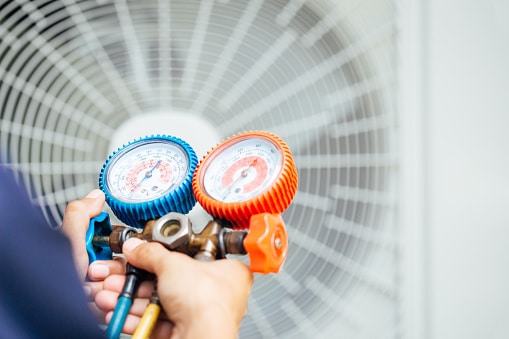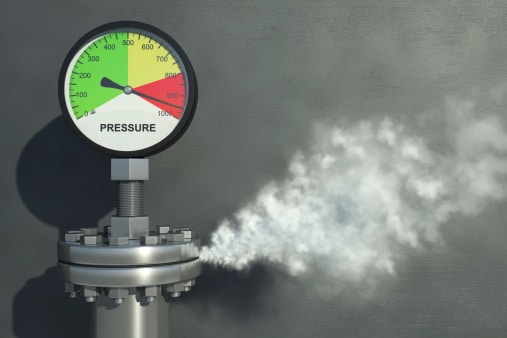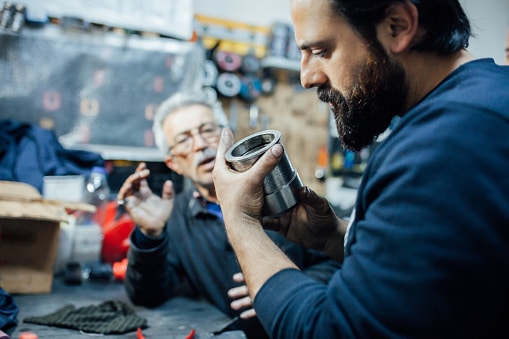How do furnaces work?
how do furnaces work?
Furnace: A furnace is a device that generates and transfers heat to materials in order to cause physical and chemical changes. Heat is often generated by the burning of solid, liquid, or gaseous fuel, or by the application of electrical energy via resistance heating (Joule heating) or inductive heating. However, if concentrated in a limited region, solar energy can provide a clean source of high temperature.
Combustion furnaces generate a hot gas that delivers heat to the material via radiation and convection. Although solids are heated directly, fluids are normally heated indirectly by being conveyed inside pipes within the furnace. A Regenerative Heat Exchanger, on the other hand, may be utilized to transfer heat from the combustion gases. Indirect heating has the advantage of not contaminating the environment with combustion products.
There are two main types of indirect heating furnaces. The first kind is boilers, which utilize heat to produce steam for power generation or process plant use. The second type of furnace is one that is designed to heat process fluids other than water. Some of the latter are typical heaters that merely raise the temperature of the fluid, while others are process heaters that cause physical and chemical changes in the products, such as distillation and pyrolysis of hydrocarbons or catalytic steam-gas reforming of synthetic natural gas
furnace repair:
Nothing is more annoying than waking up chilly in the middle of the night. It’s one thing if you only need to lift the covers. It’s a very another story if your furnace isn’t operating properly or at all. You can troubleshoot and fix your furnace yourself if you have some do-it-yourself expertise. To avoid the problem, your best strategy is to keep a maintenance checklist for your heating system.
Here are a few thermostat tests you may perform on your own:
Step 1: Check the thermostat’s battery. Your thermostat’s batteries may need to be replaced. If your thermostat is powered by batteries, make sure you replace them at least once a year, or as needed. Some thermostats are hardwired into the home’s electrical system, while others are powered by batteries. How does yours work? When a battery has to be replaced, it will sometimes display a low-battery indicator.
Step 2: Gently blow out any dust or debris that may have jammed the thermostat.
Step 3: Check the date and time on electronic or programmable types; the system may be set on a timer.
Step 4: Examine the breaker. If the power is on, switch off the breaker and check the furnace fuse.
This might happen for a variety of modest causes. First, make sure the thermostat is set to “Heat.” Then, move the dial up or down a few degrees to see whether there is a perceptible difference. Whether there is no response, check to determine if a circuit breaker or fuse has been tripped or blown.
goodman furnace:
Goodman Air Conditioning & Heating, a Daikin company, is a renowned manufacturer of HVAC devices such as air conditioners, heat pumps, and gas furnaces. It is a less expensive alternative to its sister firm, Amana Heating & Air Conditioning, and takes pride in not just its guarantee but also in testing each heating and cooling equipment three times before it leaves the manufacturing line. Goodman Air Conditioning & Heating is ranked third on our list of the Best HVAC Companies of 2022. Goodman has carved out a name for itself by making high-quality air conditioners, heat pumps, and furnaces at reasonable costs since its inception in 1975. It is also known for having one of the finest warranties in the business, and it develops, engineers and assembles all of its products in the US.
Goodman HVAC systems aren’t the most technologically sophisticated or energy efficient on the market, but they are among the most dependable. They’re also reasonably priced for the quality they provide, which is backed by a 10-year limited components guarantee and a two- or 10-year unit replacement warranty. Some of the better items from the firm also come with lifetime compressor or heat exchanger warranties. According to customers, Goodman’s overall warranty is among the finest in the business.
Goodman has prioritized durability since being bought by Daikin in 2012. It employs Copeland components in its central air conditioners and heat pumps, which are housed in galvanized steel casings that have been spray-salt tested for 500 hours to ensure they can endure harsh conditions. Goodman furnaces are also tough, with an aluminized-steel heat exchanger. Finally, each product is examined three times before it exits the production line.
Before installation, Goodman units are often less expensive than equivalent rival items. Although some HVAC businesses charge extra to install a Goodman device, reviewers believe you will save significantly over other name-brand HVAC companies’ goods. Goodman HVAC systems have a few limitations despite their reliability, low cost, and great warranties. According to reviews, while Goodman’s central air conditioners and heat pumps have good season energy efficiency ratio (SEER) ratings, its portfolio does not top the industry in energy savings. Goodman also does not have the quietest models on the market and only offers gas furnaces (not oil). Still, for the majority of consumers, Goodman provides exactly what they seek: a high-quality, long-lasting system with a decent guarantee at a reasonable price.
electric furnace:
Electric furnace, is a heating chamber that uses electricity as a heat source to achieve extremely high temperatures in order to melt and alloy metals and refractory materials. The electricity has no electrochemical impact on the metal, except by heating it. Arc furnaces and induction furnaces are the two most common types of modern electric furnaces. The resistance furnace, a third kind, is still employed in the manufacture of silicon carbide and electrolytic aluminum; in this form, the furnace charge (i.e., the material to be heated) acts as the resistance element. The heat-producing current is injected via electrodes buried in the metal in one form of resistance furnace. Heat can also be generated using resistance components that line the interior of the furnace.
Electric furnaces manufacture approximately two-fifths of the steel produced in the United States. They are utilized by specialty steelmakers to manufacture nearly all of the stainless steel, electrical steel, tool steel, and special alloys required by the chemical, automotive, aerospace, machine-tool, transportation, and food-processing sectors. Electric furnaces are also used exclusively by mini-mills, which are tiny factories that use scrap charges to manufacture reinforcing bars, merchant bars (such as angles and channels), and structural sections.
gas furnace:
There are several heating alternatives available for your house. Electric furnaces, gas furnaces, and convection heaters all have advantages and disadvantages, making it difficult to choose which is ideal for your household. Comfort Masters Heating & Air Conditioning’s committed staff produced an informative reference for the many types of heaters that you may use in your house.
Understanding the various components of your gas furnace might help you better comprehend the various heating cycles. Knowing this can help you identify a potential issue. Here’s a breakdown of the heating stages:
Step 1: Thermostat instructs the furnace to heat the house. When your home becomes too chilly, your thermostat will signal your furnace that it needs to warm up. Your furnace will not turn on without this order. If you are experiencing heating problems, you should first check your thermostat. Your heating system may be able to be restarted with a simple battery swap.
Step 2: The Burner is lit with natural gas. When your thermostat transmits a low-voltage order to warm the house, a valve opens, enabling natural gas to flow to the burner. The blower then directs the incoming ducting air towards the burner to begin warming it.
Step 3: Turn on the burner. A pilot light, also known as electronic ignition, ignites the burner from within the combustion chamber as the gas is directed towards it. This warms the natural gas through which the incoming air flows, allowing the air to warm up before being carried back to the ducts.
Step 4: Separating the Clean Air from the Combustion Waste. You want your home’s air to be clean. Your heater is responsible for ensuring that waste does not accompany your air when it is reintroduced into your house. This is performed by forcing air through a hot-air plenum. A flue collects any exhaust and directs it away from the home and outside, keeping those within safe from hazardous pollutants.
Step 5: Distribute and Re-distribute. The cold air is driven back towards the furnace by the ducts as the warm air exits the ductwork and enters its residence, leaving the warm air alone in the room. This keeps you and your family warm and comfortable. As the initial warmer air cools, more warm air replaces it, and the cycle continues until the heater is turned off.
Lennox furnace:
Most Lennox furnaces are gas-powered, while others are oil-powered. Distinct furnace models offer different features within those two fuel kinds. Variable speed, ultra-low emission, and two-stage furnaces are examples of different types. Variable speed furnaces save running expenses by preventing excessive temperature changes and delivering constant heating with lower humidity. Emissions are quite low. Lennox furnaces remove more NOx pollutants, resulting in cleaner emissions that are better for you and the environment. Two-stage furnaces include high and low output levels that allow the furnace heat flow to be calibrated to the thermostat settings. Constant torque motors in furnaces enhance efficiency while providing more comfort and cost savings.
The cost of Lennox furnaces is affected by factors such as home size, installation cost, and furnace type. Lennox does not publish individual unit costs due to the factors involved in the ultimate cost. Contact a local HVAC specialist for the most up-to-date price information. The Lennox furnace price structure is divided into three tiers: the Dave Lennox Signature Collection series, the Elite series, and the Merit series.
new furnace cost:
Depending on the size of your house, the efficiency of your new furnace, and the sophistication of the technology, a new furnace replacement can cost between $3,000 and $7,600. This covers not just equipment expenditures but also labour and permit fees. The above range includes smaller homes all the way up to 5,000 square foot residences. It also comprises single-stage, two-stage, and variable-speed furnaces in conventional and high-efficiency variants. The size of your property and your comfort preferences will influence the ultimate cost within that range.




